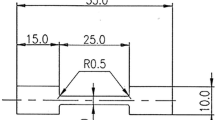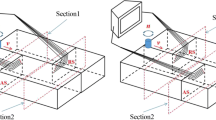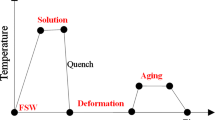Abstract
Creep ageing forming (CAF) has been widely used in the aerospace engineering, but how to optimize the processing conditions, especially under complex stress state of the CAF process for large-size components produced by friction-stir welding is still a great challenge to now. In this work, the creep ageing behaviors and underlying microstructure evolution of a thick friction-stir welded Al-Cu alloy plate after CAF process under different stress levels are systematically investigated. The creep strain and the strength of the joint are both significantly increased when the stress is close to the average yield strength of the initial weld joint. The grain size reduces while the local strain and dislocation density increase from top to bottom of the NZ; hence, the bottom layer of the weld joint exhibits higher creep strain and steady-stage creep strain rate during the CAF process. The results reveal that the gradient microstructures sensitive to the stress level effectively govern the creep-ageing performance from the upper to the bottom layer in a thick friction stir welded Al-Cu alloy plate. Rationally increasing the initial dislocation density of the weld joint can both enhance the tensile properties and promote the creep deformation of the weld joint for CAF process.
摘要
蠕变时效成形(CAF)在航空航天领域有着广泛的应用。但是,蠕变时效过程中复杂的应力状态对搅拌摩擦焊(FSW)制造的超大型尺寸构件成形是一个巨大的挑战。为了更好地制定并优化这类构件的蠕变时效成形工艺,需要系统地研究应力对焊缝组织性能演变的作用规律。本文系统地研究了不同应力水平下厚板铝铜合金搅拌摩擦焊接头的蠕变行为和微观组织演变规律。结果表明,随着外加应力的增大,焊缝的蠕变行为变化较母材更敏感。当应力增加到接近初始焊缝的平均屈服强度时(140 MPa),焊缝的蠕变量与强度都得到了显著提高。同时,在厚度方向上焊缝的蠕变行为存在差异,这与焊核区内部的不均匀梯度组织有着密不可分的联系。研究结果显示,焊核区沿厚度方向从上到下晶粒尺寸逐渐减小,而局部应变和位错密度逐渐增加,这使得焊缝底层在蠕变时效过程中表现出较高的蠕变量和稳态蠕变速率。随着外加应力的提高,焊缝蠕变时效后各区域内析出相的尺寸逐渐减小。 此外,在相同的应力水平下,蠕变时效后焊核区内部的析出相形貌和尺寸分布自上而下发生了变化。 其中,焊核区的上层与中层分布着大量的细小θ″相,而较大尺寸的θ′相分布在焊核区底层。因此,可以通过寻求合适的预处理工艺来增加焊缝的初始位错密度,进而提高接头的蠕变性能。
Similar content being viewed by others
Reference
HOLMAN M C. Autoclave age forming large aluminum aircraft panels [J]. Journal of Mechanical Working Technology, 1989, 20: 477–488. DOI: https://doi.org/10.1016/0378-3804(89)90055-7.
HORITA Z, OHASHI K, FUJITA T, et al. Achieving high strength and high ductility in precipitation-hardened alloys [J]. Advanced Materials, 2005, 17(13): 1599–1602. DOI: https://doi.org/10.1002/adma.200500069.
ZHAN Li-hua, LIN Jian-guo, DEAN T A. A review of the development of creep age forming: Experimentation, modelling and applications [J]. International Journal of Machine Tools and Manufacture, 2011, 51(1): 1–17. DOI: https://doi.org/10.1016/j.ijmachtools.2010.08.007.
YANG You-liang, ZHAN Li-hua, SHEN Ru-lin, et al. Effect of pre-deformation on creep age forming of 2219 aluminum alloy: Experimental and constitutive modelling [J]. Materials Science and Engineering A, 2017, 683: 227–235. DOI: https://doi.org/10.1016/j.msea.2016.12.024.
CHEN Xue-ying, ZHAN Li-hua, MA Zi-yao, et al. Study on tensile/compressive asymmetry in creep ageing behavior of Al−Cu alloy under different stress levels [J]. Journal of Alloys and Compounds, 2020, 843: 156157. DOI: https://doi.org/10.1016/j.jallcom.2020.156157.
MA Zi-yao, ZHAN Li-hua, LIU Chun-hui, et al. Stress-level-dependency and bimodal precipitation behaviors during creep ageing of Al−Cu alloy: Experiments and modeling [J]. International Journal of Plasticity, 2018, 110: 183–201. DOI: https://doi.org/10.1016/j.ijplas.2018.07.001.
SOUSA ARAUJO J V, MILAGRE M X, FERREIRA R O, et al. Microstructural characteristics of the Al alloys: The dissimilarities among the 2xxx alloys series used in aircraft structures [J]. Metallography, Microstructure, and Analysis, 2020, 9(5): 744–758. DOI: https://doi.org/10.1007/s13632-020-00688-5.
LAM A C L, SHI Zhu-sheng, YANG Hao-liang, et al. Creep-age forming AA2219 plates with different stiffener designs and pre-form age conditions: Experimental and finite element studies [J]. Journal of Materials Processing Technology, 2015, 219: 155–163. DOI: https://doi.org/10.1016/j.jmatprotec.2014.12.012.
LIU H, PAPADIMITRIOU I, LIN F X, et al. Precipitation during high temperature aging of Al−Cu alloys: A multiscale analysis based on first principles calculations [J]. Acta Materialia, 2019, 167: 121–135. DOI: https://doi.org/10.1016/j.actamat.2019.01.024.
MA Pei-pei, LIU Chun-hui, MA Zi-yao, et al. Formation of a new intermediate phase and its evolution toward θ′ during aging of pre-deformed Al−Cu alloys [J]. Journal of Materials Science & Technology, 2019, 35(5): 885–890. DOI: https://doi.org/10.1016/j.jmst.2018.11.022.
AHMADI M R, POVODEN-KARADENIZ E, ÖKSÜZ K I, et al. A model for precipitation strengthening in multi-particle systems [J]. Computational Materials Science, 2014, 91: 173–186. DOI: https://doi.org/10.1016/j.commatsci.2014.04.025.
LIU H, BELLÓN B, LLORCA J. Multiscale modelling of the morphology and spatial distribution of θ′ precipitates in Al−Cu alloys [J]. Acta Materialia, 2017, 132: 611–626. DOI: https://doi.org/10.1016/j.actamat.2017.04.042.
NIE J F, MUDDLE B C. Strengthening of an Al−Cu−Sn alloy by deformation-resistant precipitate plates [J]. Acta Materialia, 2008, 56(14): 3490–3501. DOI: https://doi.org/10.1016/j.actamat.2008.03.028.
LIU Chun-hui, MA Zi-yao, MA Pei-pei, et al. Multiple precipitation reactions and formation of θ′-phase in a pre-deformed Al−Cu alloy [J]. Materials Science and Engineering A, 2018, 733: 28–38. DOI: https://doi.org/10.1016/j.msea.2018.07.039.
GONG Yan-li, GAO Lin, LI Kai, et al. Structural instability of plate-shaped θ′ precipitates in an aged Al−Cu alloy [J]. Philosophical Magazine Letters, 2020, 100(11): 524–532. DOI: https://doi.org/10.1080/09500839.2020.1810861.
NANDAN R, DEBROY T, BHADESHIA H K D H. Recent advances in friction-stir welding — Process, weldment structure and properties [J]. Progress in Materials Science, 2008, 53(6): 980–1023. DOI: https://doi.org/10.1016/j.pmatsci.2008.05.001.
HU Yan-ying, LIU Hui-jie, DU Shuai-shuai. Achievement of high-strength 2219 aluminum alloy joint in a broad process window by ultrasonic enhanced friction stir welding [J]. Materials Science and Engineering A, 2021, 804: 140587. DOI: https://doi.org/10.1016/j.msea.2020.140587.
XU Wei-feng, LIU Jin-he, LUAN Guo-hong, et al. Microstructure and mechanical properties of friction stir welded joints in 2219-T6 aluminum alloy [J]. Materials & Design, 2009, 30(9): 3460–3467. DOI: https://doi.org/10.1016/j.matdes.2009.03.018.
XU Wei-feng, LIU Jin-he, LUAN Guo-hong, et al. Temperature evolution, microstructure and mechanical properties of friction stir welded thick 2219-O aluminum alloy joints [J]. Materials & Design, 2009, 30(6): 1886–1893. DOI: https://doi.org/10.1016/j.matdes.2008.09.021.
SANTECCHIA E, CABIBBO M, GHAT M, et al. Physical modeling of the creep response of an Al−Cu−Mg alloy with a fine microstructure transformed by friction stir processing [J]. Materials Science and Engineering A, 2020, 769: 138521. DOI: https://doi.org/10.1016/j.msea.2019.138521
MILAGRE M X, MOGILI N V, DONATUS U, et al. On the microstructure characterization of the AA2098-T351 alloy welded by FSW [J]. Materials Characterization, 2018, 140: 233–246. DOI: https://doi.org/10.1016/j.matchar.2018.04.015.
ZHANG Z, XIAO B L, MA Z Y. Hardness recovery mechanism in the heat-affected zone during long-term natural aging and its influence on the mechanical properties and fracture behavior of friction stir welded 2024Al-T351 joints [J]. Acta Materialia, 2014, 73: 227–239. DOI: https://doi.org/10.1016/j.actamat.2014.04.021.
SIDHAR H, MISHRA R S, REYNOLDS A P, et al. Impact of thermal management on post weld heat treatment efficacy in friction stir welded 2050-T3 alloy [J]. Journal of Alloys and Compounds, 2017, 722: 330–338. DOI: https://doi.org/10.1016/j.jallcom.2017.06.141.
KASSNER M E, KUMAR P, BLUM W. Harper-Dorn creep [J]. International Journal of Plasticity, 2007, 23(6): 980–1000. DOI: https://doi.org/10.1016/j.ijplas.2006.10.006.
LI Fu-cheng, XIE Ya, SONG Min, et al. A detailed appraisal of the stress exponent used for characterizing creep behavior in metallic glasses [J]. Materials Science and Engineering A, 2016, 654: 53–59. DOI: https://doi.org/10.1016/j.msea.2015.12.025.
COBLE R L. A model for boundary diffusion controlled creep in polycrystalline materials [J]. Journal of Applied Physics, 1963, 34(6): 1679–1682. DOI: https://doi.org/10.1063/1.1702656.
WANG Dong-yao, ZENG Quan-qing, HE Di-qiu, et al. Inhomogeneous gradient microstructure and mechanical properties of thick copper plate via friction stir welding [J]. Journal of Materials Engineering and Performance, 2020, 29(12): 7853–7862. DOI: https://doi.org/10.1007/s11665-020-05296-6.
WANG Dong-yao, ZHAN Li-hua, ZENG Quan-qing, et al. Study of desirable precipitate-strengthening effects on friction-stir welded joints of third-generation Al−Cu−Li alloys [J]. Philosophical Magazine Letters, 2021, 101(12): 474–483. DOI: https://doi.org/10.1080/09500839.2021.1980833.
BARRETT C R, LYTTON J L, SHERBY O D. Effect of grain size and annealing treatment on steady state creep of copper [R]. Defense Technical Information Center, 1965. DOI: https://doi.org/10.21236/ad0615926.
FANG T T, MURTY K L. Grain-size-dependent creep of stainless steel [J]. Materials Science and Engineering, 1983, 61(3): L7–L10. DOI: https://doi.org/10.1016/0025-5416(83)90115-5.
FIGUREUEIREDO R B, LANGDON T G. Analysis of the creep behavior of fine-grained AZ31 magnesium alloy [J]. Materials Science and Engineering A, 2020, 787: 139489. DOI: https://doi.org/10.1016/j.msea.2020.139489.
SANTELLA M L, TORTORELLI P F, RENDER M, et al. Effects of applied stress and grain size on creep-rupture lifetime prediction for Haynes 282 alloy [J]. Materials Science and Engineering A, 2022, 838: 142785. DOI: https://doi.org/10.1016/j.msea.2022.142785
SU J Q, NELSON T W, MISHRA R, et al. Microstructural investigation of friction stir welded 7050-T651 aluminium [J]. Acta Materialia, 2003, 51(3): 713–729. DOI: https://doi.org/10.1016/S1359-6454(02)00449-4.
SU Jian-qing, NELSON T W, STERLING C J. Microstructure evolution during FSW/FSP of high strength aluminum alloys [J]. Materials Science and Engineering A, 2005, 405(1–2): 277–286. DOI: https://doi.org/10.1016/j.msea.2005.06.009.
ZENG X H, XUE P, WU L H, et al. Microstructural evolution of aluminum alloy during friction stir welding under different tool rotation rates and cooling conditions [J]. Journal of Materials Science & Technology, 2019, 35(6): 972–981. DOI: https://doi.org/10.1016/j.jmst.2018.12.024.
HUANG K, LOGÉ R E. A review of dynamic recrystallization phenomena in metallic materials [J]. Materials & Design, 2016, 111: 548–574. DOI: https://doi.org/10.1016/j.matdes.2016.09.012.
LI J Q, LIU H J. Effects of tool rotation speed on microstructures and mechanical properties of AA2219-T6 welded by the external non-rotational shoulder assisted friction stir welding [J]. Materials & Design, 2013, 43: 299–306. DOI: https://doi.org/10.1016/j.matdes.2012.07.011.
MALARD B, de GEUSER F, DESCHAMPS A. Microstructure distribution in an AA2050 T34 friction stir weld and its evolution during post-welding heat treatment [J]. Acta Materialia, 2015, 101: 90–100. DOI: https://doi.org/10.1016/j.actamat.2015.08.068.
LIU H J, FENG X L. Effect of post-processing heat treatment on microstructure and microhardness of water-submerged friction stir processed 2219-T6 aluminum alloy [J]. Materials & Design, 2013, 47: 101–105. DOI: https://doi.org/10.1016/j.matdes.2012.11.056.
BISWAS A, SIEGEL D J, WOLVERTON C, et al. Precipitates in Al−Cu alloys revisited: Atom-probe tomographic experiments and first-principles calculations of compositional evolution and interfacial segregation [J]. Acta Materialia, 2011, 59(15): 6187–6204. DOI: https://doi.org/10.1016/j.actamat.2011.06.036.
BOURGEOIS L, DWYER C, WEYLAND M, et al. Structure and energetics of the coherent interface between the θ′ precipitate phase and aluminium in Al−Cu [J]. Acta Materialia, 2011, 59(18): 7043–7050. DOI: https://doi.org/10.1016/j.actamat.2011.07.059.
LIU Chun-hui, YANG Jian-shi, MA Pei-pei, et al. Large creep formability and strength-ductility synergy enabled by engineering dislocations in aluminum alloys [J]. International Journal of Plasticity, 2020, 134: 102774. DOI: https://doi.org/10.1016/j.ijplas.2020.102774.
MA Pei-pei, ZHAN Li-hua, LIU Chun-hui, et al. Strong stress-level dependence of creep-ageing behavior in Al−Cu−Li alloy [J]. Materials Science and Engineering A, 2021, 802: 140381. DOI: https://doi.org/10.1016/j.msea.2020.140381.
NABARRO F R N. Creep in commercially pure metals [J]. Acta Materialia, 2006, 54(2): 263–295. DOI: https://doi.org/10.1016/j.actamat.2005.08.021.
WEERTMAN J. Creep of aluminum single crystals [J]. Journal of Applied Physics, 1956, 27(7): 832–834. DOI: https://doi.org/10.1063/1.1722492.
GAO S, WU C S, PADHY G K, et al. Evaluation of local strain distribution in ultrasonic enhanced Al6061-T6 friction stir weld nugget by EBSD analysis [J]. Materials & Design, 2016, 99: 135–144. DOI: https://doi.org/10.1016/j.matdes.2016.03.055.
MORADI M M, JAMSHIDI AVAL H, JAMAATI R, et al. Microstructure and texture evolution of friction stir welded dissimilar aluminum alloys: AA2024 and AA6061 [J]. Journal of Manufacturing Processes, 2018, 32: 1–10. DOI: https://doi.org/10.1016/j.jmapro.2018.01.016.
CALCAGNOTTO M, PONGE D, DEMIR E, et al. Orientation gradients and geometrically necessary dislocations in ultrafine grained dual-phase steels studied by 2D and 3D EBSD [J]. Materials Science and Engineering A, 2010, 527(10–11): 2738–2746. DOI: https://doi.org/10.1016/j.msea.2010.01.004.
HE Z F, JIA N, MA D, et al. Joint contribution of transformation and twinning to the high strength-ductility combination of a FeMnCoCr high entropy alloy at cryogenic temperatures [J]. Materials Science and Engineering A, 2019, 759: 437–447. DOI: https://doi.org/10.1016/j.msea.2019.05.057.
PAN Hu-cheng, KANG Rui, LI Jing-ren, et al. Mechanistic investigation of a low-alloy Mg−Ca-based extrusion alloy with high strength-ductility synergy [J]. Acta Materialia, 2020, 186: 278–290. DOI: https://doi.org/10.1016/j.actamat.2020.01.017.
LI He, ZHAN Li-hua, HUANG Ming-hui, et al. Effects of pre-strain and stress level on stress relaxation ageing behaviour of 2195 Al−Li alloy: Experimental and constitutive modelling [J]. Journal of Alloys and Compounds, 2021, 851: 156829. DOI: https://doi.org/10.1016/j.jallcom.2020.156829.
CHEN Long-hui, LIU Chun-hui, MA Pei-pei, et al. Strong inplane anisotropy of creep ageing behavior in largely pre-deformed Al−Cu alloy: Experiments and constitutive modeling [J]. International Journal of Plasticity, 2022, 152: 103245. DOI: https://doi.org/10.1016/j.ijplas.2022.103245.
MA Pei-pei, ZHAN Li-hua, LIU Chun-hui, et al. Pre-strain-dependent natural ageing and its effect on subsequent artificial ageing of an Al−Cu−Li alloy [J]. Journal of Alloys and Compounds, 2019, 790: 8–19. DOI: https://doi.org/10.1016/j.jallcom.2019.03.072.
Author information
Authors and Affiliations
Contributions
The overarching research goals were developed by ZHAN Li-hua and ZHONG Jue. ZHAN Li-hua provided the fund supports. TANG Zhi-mao and ZENG Quan-qing conducted the literature review and provided the measured creep tests data. WANG Dong-yao analyzed the measured data and edited the draft of manuscript. ZHAN Li-hua, ZHONG Jue and GAN Ke-fu edited the manuscript.
Corresponding author
Additional information
Conflict of interest
No potential conflict of interest was reported by the authors.
Foundation item: Project(2021YFB3400903) supported by the National Key R&D Program of China; Project(1053320211480) supported by the Science and Technology Innovation Project of Graduate Students of Central South University, China
Rights and permissions
About this article
Cite this article
Wang, Dy., Zhan, Lh., Zhong, J. et al. Stress-level dependency of creep ageing behavior for friction stir welded Al-Cu alloy. J. Cent. South Univ. 29, 3030–3053 (2022). https://doi.org/10.1007/s11771-022-5139-x
Received:
Accepted:
Published:
Issue Date:
DOI: https://doi.org/10.1007/s11771-022-5139-x
Key words
- creep age forming
- friction stir welding
- inhomogeneous gradient microstructure
- thick Al-Cu alloy plate
- precipitation microstructure evolution
- mechanical property




